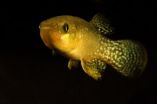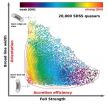(Press-News.org) Sharks in no-fishing zones in the Great Barrier Reef (GBR) Marine Park are more abundant when the coral is healthy, according to a study published September 10, 2014 in the open-access journal PLOS ONE by Mario Espinoza from James Cook University, Australia and colleagues.
Shark species that use coral reefs may be under pressure from fishing, habitat degradation, and climate change. The authors of this study were interested in understanding the factors that affect the distribution and abundance of shark populations in the GBR, including fishing and habitat quality. To examine the distribution patterns and habitat associations of sharks, the scientists used thousands of baited remote underwater video stations (BRUVS) across the entire GBR Marine Park over a 10-year period to record animals attracted to the bait, allowing them to count and identify any sharks present.
Overall, researchers recorded 21 different shark species. The relative abundance of sharks was significantly higher in non-fished sites in the GBR Marine Park no-fishing zones relative to fished sites. However, their findings also showed that hard coral cover had a large effect on the abundance of reef-associates shark species, indicating that the success of marine reserves for sharks, particularly reef-associated species, may depend on coral reef health. "Our results suggest that healthy reefs make good shark habitat, and may be just as important for improving shark numbers as protecting sharks from fishing," Mr. Espinoza said. The study also showed that since the creating no-fishing zones in the GBR in 2004, some shark species found on coral reefs had increased, and that one particular shark, the grey reef shark, had increased in abundance since more of the reef became protected.
The authors hope that this study emphasizes how important the coral reef health is for the future of shark populations, and that it may help others better understand the role of reef health in assessing the benefits of marine-protected areas for sharks.
INFORMATION:
Adapted by PLOS ONE from release provided by the authors.
In your coverage please use this URL to provide access to the freely available paper: http://dx.plos.org/10.1371/journal.pone.0106885
Citation: Espinoza M, Cappo M, Heupel MR, Tobin AJ, Simpfendorfer CA (2014) Quantifying Shark Distribution Patterns and Species-Habitat Associations: Implications of Marine Park Zoning. PLoS ONE 9(9): e106885. doi:10.1371/journal.pone.0106885
Funding: Funding for this analysis was provided by the Australian Government's National Environmental Research Program (Tropical Ecosystems Hub Project 6.1) awarded to MRH, CAS, and AJT. MRH was supported by a Future Fellowship (#FT100101004) from the Australian Research Council, and ME was supported by Australian Endeavour and AIMS@JCU Scholarships. This study is also an output of the 'Great Barrier Reef Seabed Biodiversity Project', which was funded by the CRC Reef Research Centre, the Fisheries Research and Development Corporation (FRDC), and the National Oceans Office, and led by R. Pitcher (Principal Investigator, CSIRO), P. Doherty (AIMS), J. Hooper (QM), and N. Gribble (QDPIF). The funders had no role in study design, data collection and analysis, decision to publish, or preparation of the manuscript.
Competing Interests: The authors have declared that no competing interests exist.
Sharks more abundant on healthy coral reefs
Coral health, no-fishing zones impact Great Barrier Reef shark populations
2014-09-10
ELSE PRESS RELEASES FROM THIS DATE:
Gulf killifishes' biological responses to oil spills similar in field, laboratory studies
2014-09-10
Gulf killifish biological responses to the Deepwater Horizon oil spill detected by researchers in the field are similar to those in controlled laboratory studies, according to a study published September 10, 2014 in the open-access journal PLOS ONE by Whitney Pilcher from Louisiana State University and colleagues.
After the Deepwater Horizon oil spill, scientists monitored the impacts of oil on a local species of fish, the Gulf killifish. Changes in genome expression responses to oil exposure may provide insight into how the fish are affected by or adapt to environmental ...
New study shows impact of movies on dog breed popularity
2014-09-10
The effect of movies featuring dogs on the popularity of dog breeds can last up to ten years and is correlated with the general success of the movies, according to new research from the University of Bristol, the City University of New York, and Western Carolina University.
The study, published today in PLOS ONE, also found that movies' influence was strongest in the early twentieth century and has declined since.
The researchers used data from the American Kennel Club, which maintains the world's largest dog registry totalling over 65 million dogs, and analysed a total ...
New 3-D imaging techniques may improve understanding of biofuel plant material
2014-09-10
Comparison of 3D TEM imaging techniques reveals never-seen-before details of plant cell walls, according to a study published September 10, 2014 in the open-access journal PLOS ONE by Purbasha Sarkar from University of California, Berkeley and colleagues.
Cost-effective production of plant material for biofuel requires efficient breakdown of plant cell wall tissue to retrieve the complex sugars in the cell wall required for fermentation and production of biofuels. In-depth knowledge of plant cell wall composition is therefore essential for improving the fuel production ...
New study examines impact of violent media on the brain
2014-09-10
(NEW YORK – September 10, 2014) With the longstanding debate over whether violent movies cause real world violence as a backstop, a study published today in PLOS One found that each person's reaction to violent images depends on that individual's brain circuitry, and on how aggressive they were to begin with.
The study, which was led by researchers at the Icahn School of Medicine at Mount Sinai and the NIH Intramural Program, featured brain scans which revealed that both watching and not watching violent images caused different brain activity in people with different ...
Study ties groundwater to human evolution
2014-09-10
Our ancient ancestors' ability to move around and find new sources of groundwater during extremely dry periods in Africa millions of years ago may have been key to their survival and the evolution of the human species, a new study shows.
The research – published in the journal PLOS ONE – combines geological evidence from the Olduvai sedimentary basin in Northern Tanzania, which formed about 2.2 million years ago, and results from a hydrological model.
It shows that while water in rivers and lakes would have disappeared as the climate changed due to variations in the ...
Is spooning really the best position for men with back pain?
2014-09-10
September 10, 2014 – A study using motion capture technology provides new information on the spinal strain produced by various sexual positions—suggesting that one position commonly recommended for all men with low back pain is not actually the best choice, reports a study in the journal Spine. The journal is published by Lippincott Williams & Wilkins, a part of Wolters Kluwer Health.
The results provide a more scientific basis for making individualized recommendations regarding sexual positions for men with low back pain, according to Natalie Sidorkewicz, MSc, and Stuart ...
Seismic gap may be filled by an earthquake near Istanbul
2014-09-10
When a segment of a major fault line goes quiet, it can mean one of two things: The "seismic gap" may simply be inactive — the result of two tectonic plates placidly gliding past each other — or the segment may be a source of potential earthquakes, quietly building tension over decades until an inevitable seismic release.
Researchers from MIT and Turkey have found evidence for both types of behavior on different segments of the North Anatolian Fault — one of the most energetic earthquake zones in the world. The fault, similar in scale to California's San Andreas Fault, ...
Gibbon genome sequence deepens understanding of primates rapid chromosomal rearrangements
2014-09-10
HOUSTON – (Sep. 10. 2014) – With the completion of the sequencing and analysis of the gibbon genome, scientists now know more about why this small ape has a rapid rate of chromosomal rearrangements, providing information that broadens understanding of chromosomal biology.
Chromosomes, essentially the packaging that encases the genetic information stored in the DNA sequence, are fundamental to cellular function and the transmission of genetic information from one generation to the next. Chromosome structure and function is also intimately related to human genetic diseases, ...
Mysterious quasar sequence explained
2014-09-10
Pasadena, CA—Quasars are supermassive black holes that live at the center of distant massive galaxies. They shine as the most luminous beacons in the sky across the entire electromagnetic spectrum by rapidly accreting matter into their gravitationally inescapable centers. New work from Carnegie's Hubble Fellow Yue Shen and Luis Ho of the Kavli Institute for Astronomy and Astrophysics (KIAA) at Peking University solves a quasar mystery that astronomers have been puzzling over for 20 years. Their work, published in the September 11 issue of Nature, shows that most observed ...
Researchers discover 3 extinct squirrel-like species
2014-09-10
Paleontologists have described three new small squirrel-like species that place a poorly understood Mesozoic group of animals firmly in the mammal family tree. The study, led by scientists at the American Museum of Natural History and the Chinese Academy of Sciences, supports the idea that mammals—an extremely diverse group that includes egg-laying monotremes such as the platypus, marsupials such as the opossum, and placentals like humans and whales—originated at least 208 million years ago in the late Triassic, much earlier than some previous research suggests. The study ...
LAST 30 PRESS RELEASES:
Numbers in our sights affect how we perceive space
SIMJ announces global collaborative book project in commemoration of its 75th anniversary
Air pollution exposure and birth weight
Obstructive sleep apnea risk and mental health conditions among older adults
How talking slows eye movements behind the wheel
The Ceramic Society of Japan’s Oxoate Ceramics Research Association launches new international book project
Heart-brain connection: international study reveals the role of the vagus nerve in keeping the heart young
Researchers identify Rb1 as a predictive biomarker for a new therapeutic strategy in some breast cancers
Survey reveals ethical gaps slowing AI adoption in pediatric surgery
Stimulant ADHD medications work differently than thought
AI overestimates how smart people are, according to HSE economists
HSE researchers create genome-wide map of quadruplexes
Scientists boost cell "powerhouses" to burn more calories
Automatic label checking: The missing step in making reliable medical AI
Low daily alcohol intake linked to 50% heightened mouth cancer risk in India
American Meteorological Society announces Rick Spinrad as 2026 President-Elect
Biomass-based carbon capture spotlighted in newly released global climate webinar recording
Illuminating invisible nano pollutants: advanced bioimaging tracks the full journey of emerging nanoscale contaminants in living systems
How does age affect recovery from spinal cord injury?
Novel AI tool offers prognosis for patients with head and neck cancer
Fathers’ microplastic exposure tied to their children’s metabolic problems
Research validates laboratory model for studying high-grade serous ovarian cancer
SIR 2026 delivers transformative breakthroughs in minimally invasive medicine to improve patient care
Stem Cell Reports most downloaded papers of 2025 highlight the breadth and impact of stem cell research
Oxford-led study estimates NHS spends around 3% of its primary and secondary care budget on the health impacts of heat and cold in England
A researcher’s long quest leads to a smart composite breakthrough
Urban wild bees act as “microbial sensors” of city health.
New study finds where you live affects recovery after a hip fracture
Forecasting the impact of fully automated vehicle adoption on US road traffic injuries
Alcohol-related hospitalizations from 2016 to 2022
[Press-News.org] Sharks more abundant on healthy coral reefsCoral health, no-fishing zones impact Great Barrier Reef shark populations



